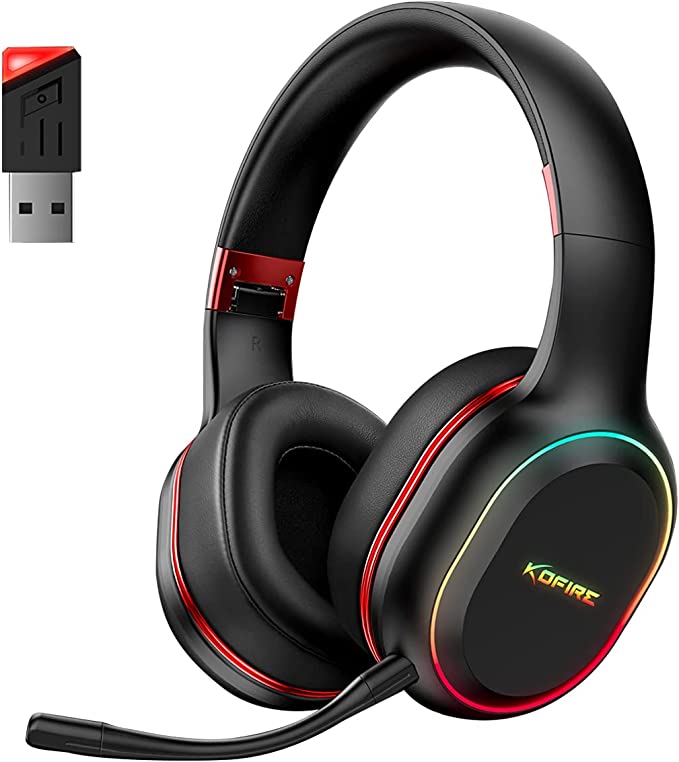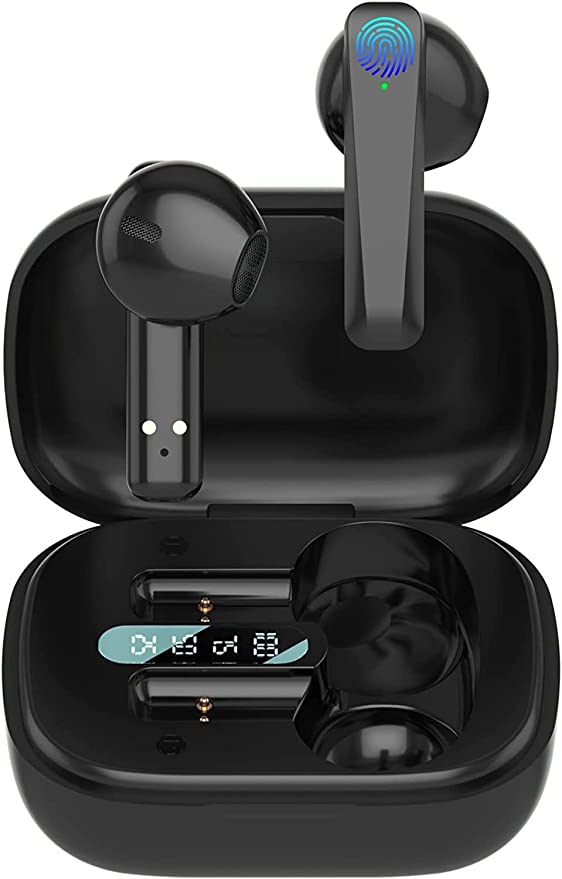We live immersed in a symphony, often chaotic, of sound. The gentle hum of a refrigerator, the distant city traffic, the chatter of a bustling café, the roar of a jet engine – our ears are constantly processing an intricate soundscape. While sometimes vibrant and welcome, this auditory flood can often feel overwhelming, making focus elusive and personal audio enjoyment a challenge. In this quest for auditory control, headphones have evolved from simple sound conduits into sophisticated instruments for shaping our personal acoustic space. The Picun ANC-05L headphones, with their blend of modern audio technologies, offer a fascinating case study in how science and engineering work together to grant us a measure of mastery over what we hear. Let’s peel back the layers and explore the science that makes this possible.

The Art of Silence: Unveiling Active Noise Cancellation (ANC)
Imagine settling into your seat for a long flight, the drone of the engines a persistent, wearying presence. Or picture yourself trying to concentrate in a noisy open-plan office, the surrounding conversations a constant distraction. This is where Active Noise Cancellation (ANC) steps in, not as a mere sound blocker, but as a clever manipulator of physics.
The core idea, though sophisticated in execution, is elegantly simple and dates back further than you might think, with early concepts emerging decades ago, notably inspired by the need to reduce noise in aircraft cockpits. It hinges on a fundamental principle of wave physics: destructive interference. Think of sound as waves traveling through the air. Just like ripples on a pond, when two waves meet, they can interact. If the peak of one wave meets the trough (the lowest point) of another wave of equal amplitude, they cancel each other out at that point.
ANC headphones harness this phenomenon electronically:
- Listen: Tiny microphones, strategically placed on the outside (and sometimes inside) of the earcups, act as vigilant ears, constantly sampling the ambient noise surrounding you – particularly those persistent, low-frequency sounds like engine hums or air conditioning whirs.
- Analyze & Invert: A dedicated digital signal processing (DSP) chip inside the headphones instantly analyzes the captured sound waves. Its crucial task is to generate a new sound wave that is the exact opposite – or ‘anti-noise’ – of the incoming noise. This anti-noise has the same amplitude but an inverted phase (think of it as a perfect mirror image).
- Cancel: The headphone’s own speakers then emit this precisely calculated anti-noise wave. When the original external noise wave and the internally generated anti-noise wave reach your eardrum simultaneously, they effectively neutralize each other.
It’s important to understand that ANC is most effective against continuous, low-frequency noise. It’s less adept at cancelling sudden, sharp sounds (like a door slam) or higher-frequency chatter. This is also where passive noise isolation plays a crucial role. The physical design of the over-ear earcups, especially when using materials like memory foam, creates a seal around your ears, physically blocking a good portion of ambient sound before the electronics even need to engage. It’s a two-pronged approach to quiet.
The Picun ANC-05L features this Active Noise Cancelling technology, with the manufacturer stating it can reduce noise in environments like aviation, subways, and crowded spaces by up to 95% (a figure provided by Picun, reflecting their internal testing and performance target). A dedicated button allows you to easily switch the ANC function on or off, letting you choose when to retreat into your sound bubble.

Clear Conversations Amidst the Clamor: The Mystery of ENC
While ANC curates the sound you hear, Environmental Noise Cancellation (ENC) focuses on ensuring others hear you clearly, especially during phone calls. We’ve all experienced the frustration of trying to hold a conversation on a windy street or amidst background hubbub, forcing us to repeat ourselves or shout. ENC technology tackles this specific challenge.
Think of it this way: ANC is about creating silence for your ears; ENC is about creating clarity for the ears on the other end of the line. It primarily works its magic on the microphone system. Often employing multiple microphones (an array), ENC uses sophisticated algorithms, again powered by a DSP chip, to achieve several things:
- Isolate Your Voice: Techniques like beamforming allow the microphones to “focus” on the sound coming from your mouth, treating it as the primary signal.
- Identify Noise: The system analyzes the incoming sound from all microphones to identify patterns characteristic of background noise (wind, traffic, indistinct chatter).
- Suppress Noise: It then actively filters out or reduces the volume of these identified ambient sounds before transmitting your voice signal.
The Picun ANC-05L incorporates this ENC technology for its built-in microphone. According to the product description, it automatically enables this call noise reduction function when you’re on a call using Bluetooth, aiming to shield the person you’re talking to from your surrounding noise and enhance your voice pick-up for clearer communication. It’s worth noting, as Picun points out, that this microphone and its ENC feature are designed to work specifically when connected via Bluetooth, not when using the 3.5mm audio cable. Imagine taking that important call while waiting for your train – ENC is the unsung hero working to make sure your message gets through cleanly.
The Unseen Tether: Bluetooth 5.3 and the Evolution of Wireless Freedom
The journey from tangled headphone cables to the seamless convenience of wireless audio is a testament to the relentless march of technology. Bluetooth, the short-range wireless standard that makes this possible, has itself undergone significant evolution. The Picun ANC-05L utilizes Bluetooth 5.3, a relatively recent iteration of this standard.
While users might not perceive radical differences daily compared to slightly older versions like 5.0 or 5.2, each update to the Bluetooth standard brings under-the-hood improvements specified by the Bluetooth Special Interest Group (SIG). Generally, compared to the much older Bluetooth 4.x generation, Bluetooth 5.x standards (including 5.3) offer foundational enhancements such as:
- Improved Stability and Reliability: Connections tend to be more robust, less prone to interference and dropouts, especially in crowded radio frequency environments.
- Enhanced Energy Efficiency: Bluetooth Low Energy (LE) protocols have become more refined, potentially leading to longer battery life for both the headphones and the connected device.
- Foundation for Future Features: Newer standards pave the way for advancements like LE Audio, which promises higher audio quality at lower power consumption and improved capabilities for features like Auracast™ broadcast audio (though implementation varies by device).
Picun leverages Bluetooth 5.3 in the ANC-05L, aiming for that stable, reliable connection with the vast majority of mobile devices, laptops, and tablets. A particularly useful feature highlighted is multi-point connection, allowing the headphones to be actively paired with two devices simultaneously. Picture seamlessly switching between listening to music on your laptop and taking an incoming call on your smartphone without manually disconnecting and reconnecting – a genuine convenience for multitaskers.
And, recognizing that wireless isn’t always feasible or desired, the inclusion of a standard 3.5mm audio cable provides a universal, reliable fallback. If the battery runs out, or you want to connect to a device without Bluetooth (like an older MP3 player or an in-flight entertainment system), the wired option ensures your listening doesn’t have to stop.
The Heartbeat of Sound: Inside the 40mm Dynamic Drivers
Ultimately, headphones are about delivering sound to our ears. The component responsible for this crucial conversion of electrical signals into audible vibrations is the driver. The Picun ANC-05L employs 40mm dynamic drivers, a common and effective type found in many over-ear headphones.
Let’s demystify how a dynamic driver works, using the principles of electromagnetism:
- The Signal Arrives: An electrical audio signal, representing the music or voice, travels from your device to the headphones.
- The Voice Coil Moves: This signal flows through a finely wound coil of wire (the voice coil) which is attached to a lightweight, cone- or dome-shaped membrane (the diaphragm). This voice coil sits within a strong, permanent magnetic field created by a magnet assembly.
- Electromagnetism at Play: As the electrical audio signal fluctuates, it creates a varying magnetic field around the voice coil. This interacts with the permanent magnetic field, causing the voice coil (and the attached diaphragm) to rapidly vibrate back and forth, precisely mirroring the pattern of the original audio signal.
- Sound Waves are Born: The vibrating diaphragm pushes and pulls the air particles next to it, creating compressions and rarefactions – essentially, pressure waves that travel through the air. When these waves reach your eardrums, they vibrate in response, and your brain interprets these vibrations as sound.
The “40mm” specification refers to the diameter of the diaphragm. While not the sole determinant of sound quality, a larger diaphragm generally has the physical capacity to move more air than a smaller one. This can be particularly advantageous for reproducing lower frequencies (bass), potentially lending them more weight, impact, and depth.
However, driver size is just one piece of the puzzle. The materials used for the diaphragm (often plastics like PET, sometimes more exotic materials), the design of the magnet structure, the shape of the enclosure (the earcup itself), and critically, the acoustic tuning performed by the engineers, all profoundly influence the final sound signature. Tuning is an art, balancing frequencies to achieve a desired character – perhaps emphasizing bass for popular music, aiming for neutrality for studio monitoring, or crafting a balanced profile for general listening.
Picun states that the 40mm dynamic drivers in the ANC-05L are engineered for high-fidelity sound, aiming to deliver deep, accurate bass alongside clear treble, with a frequency response reaching up to 20 kHz. This upper limit corresponds roughly to the highest frequency typically audible by young, healthy human ears, suggesting an intent to cover the full audible spectrum.

Enduring Comfort, Lasting Power: Where Materials and Energy Converge
Advanced technology is only truly enjoyable if it’s comfortable to use for extended periods and doesn’t constantly demand a recharge. The Picun ANC-05L addresses these practicalities through thoughtful design and modern battery tech.
The science of comfort lies partly in the materials. The earcups utilize memory foam, a fascinating viscoelastic polymer. “Viscoelastic” means it exhibits both viscous (fluid-like) and elastic (spring-like) properties. When you put the headphones on, the warmth and pressure from your head cause the foam to soften and slowly conform precisely to the unique contours around your ears. This offers several benefits:
* Pressure Distribution: It spreads the clamping force of the headphones evenly, reducing pressure points and enhancing long-term comfort.
* Acoustic Seal: By creating a snug fit, it improves passive noise isolation, blocking more external sound before ANC even kicks in.
* Personalized Fit: It adapts to you, unlike standard foam padding.
This is complemented by the ergonomic design – the 100° swiveling earcups and the self-adjustable, flexible headband work together to ensure the earcups sit flush against the sides of your head, accommodating different head shapes and sizes for a secure yet gentle fit, crucial for both comfort and optimal acoustic performance. The relatively light weight of 7.1 ounces (200g) also contributes to reduced fatigue during long listening sessions.
On the power front, the headphones rely on Lithium-Ion (Li-ion) batteries, the standard for modern portable electronics due to their high energy density (packing a lot of power into a small, light package) and rechargeability. Picun claims an impressive 40 hours of playtime on a single charge (performance likely varies with volume level and ANC usage). To put that into perspective, it could potentially cover a full week or more of daily commutes or several long-haul flights without needing a recharge.
Charging is handled via the modern USB-C port, increasingly the universal standard. Furthermore, the ANC-05L supports fast charging. According to the product details, a brief 10-minute charge can provide approximately 5 hours of listening time. This is incredibly practical for those moments when you realize the battery is low just before heading out the door – a quick top-up provides substantial playtime. A full charge is stated to take around 2.5 hours.

Beyond the Buzzwords: Listening in the Modern Age
Pulling it all together, the Picun ANC-05L headphones exemplify how distinct fields of science and engineering converge in a single, everyday device. Active Noise Cancellation manipulates sound waves based on fundamental physics. Environmental Noise Cancellation uses sophisticated signal processing to untangle voice from noise. Bluetooth 5.3 represents decades of refinement in wireless communication protocols. Dynamic drivers translate electricity into audible vibrations through electromagnetism. Material science delivers comfort and acoustic sealing through memory foam. And electrochemistry provides long-lasting, fast-charging power via Li-ion batteries.
Understanding these technologies moves us beyond simply reading a spec sheet. It allows us to appreciate the ingenuity involved in crafting our personal sound experiences – whether silencing the world to focus, enjoying music with greater fidelity, communicating clearly on the move, or simply benefiting from the freedom of a reliable wireless connection and enduring comfort. In an increasingly noisy world, technology like this doesn’t just deliver sound; it offers a welcome measure of control and personalized tranquility.




